What is Yoga?
First things come first. From where did the word ‘yoga’ derive? It comes from the Sanskrit word ‘yuj’ that means ‘to join’ or ‘to unite’. So, it essentially means the union of the individual consciousness with the universal consciousness. Yoga is actually a science. It is the science of living your life right and incorporating all these right aspects into daily living. It is a science that works on the entire vital, spiritual, physical, mental, emotional and psychic aspects of a human.
Origin of Yoga
Some argue that yoga is science while some say that yoga is a spiritual discipline. Well, there is no point in arguing over such things because it is a spiritual discipline that is based essentially on subtle science that concentrates on the harmony between mind and body. It is also a harmony between Man and Nature which is essential. Once man experiences this oneness then they are sad to be in yoga and they are known as a ‘yogi’ and they have attained freedom or ‘mukti’ or ‘nirvana’ or ‘moksha’. So, the aim and essence of yoga is self-realisation to overcome all suffering and attain liberation or freedom.
History of Yoga
Yoga has been known as long as man existed, which means right from the genesis of civilization. Yoga was born even before the religious systems came into existence. According to yogic wisdom, Shiva was the first yogi or Adiyogi and the first Guru or Adiguru. Yogic lore says that thousands of years ago the Adiguru passed on his knowledge to the legendary Saptarishis or the ‘seven sages’ on the banks of the Kantisarovar in the Himalayas. These sages then carried this knowledge far and wide to various countries like Asia, the Middle East, Northern Africa and Southern America. This finds its relevance in the fact that modern scholars find close similarities between most ancient cultures across the world. And it was Saptarshi Agastya who spread this knowledge on the Indian subcontinent. Thus, was born yoga in India.
Also read – International Yoga Day 2023: History, Significance, All You Need To Know
The Various Aspects of Yoga
When yoga was born in India, it was practiced under the Guru and thus it was given a spiritual importance and value. As it as part of Upasana, yoga sadhana was instilled in the rituals. In the Vedic period the Sun was considered the Almighty and the Supreme and so came the Surya Namaskar. Pranayam became a daily ritual and a religious offering. However, it was Maharshi Patanjali, the Father of Modern Yoga, who gave a perfect symmetry and code to the existing practices, their meanings and knowledge through his Yoga Sutras. Subsequently many Sages and Yoga Masters contributed to their development.
The Historical Evidence of the Existence of Yoga
Historical evidence of yoga can be seen in the pre-Vedic age till the Patanjali period. The main source of all this evidence is to be found in the four Vedas, 108 Upanishads, Smritis, 2 Epics, 18 Puranas and the teachings of Buddhism and Jainism.
Modern Day Yoga
Sage Patanjali was the founder of modern-day yoga and Ashtanga yoga. The core of this yoga or at the centre of its inspiration lies the asanas. They are the very asanas that are practiced the world over. And so, he is rightfully known as the Father of Modern Yoga.
The Philosophy of Yoga
The philosophy behind yoga is simple. It says that mind, body and spirit are all one and cannot be separated. And it is this philosophy that believes that spiritual ignorance leads to suffering and binds the human soul to the wheel of samsara or cycle of rebirth. This removal of ignorance can liberate mankind and this is achieved travelling the many paths of and techniques of yoga. From all this it can be inferred that the ultimate goal of yoga is Moksha or Samadhi. It means surpassing and overshadowing the mind to realize the true and highest self.












